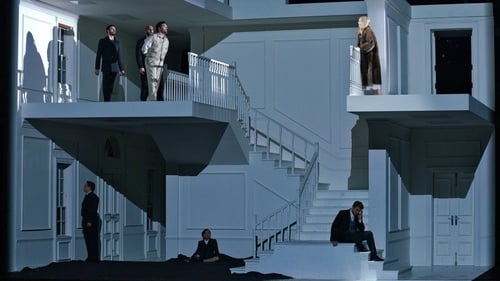
Vivaldis Orlando Furioso was chosen to open the 43rd Festival della Valle dItria. This baroque opera is a true feast for the senses, with peaks of sheer poetry and a sense of wonder. Director Fabio Ceresa was clearly inspired by the works of Gustav Klimt, both for the setting and the costumes. Conductor and Continuo Diego Fasolis leads the excellent Barocchisti ensemble with an elegant touch, and an unfailing ability to fully convey the musics nuanced coloratura. The production was very well received, with the cast highly praised by audience and critics alike. Sonia Prina proved highly convincing in the title role, both for the quality of her voice and for her outstanding acting skills - a true 'ba-rock star'. Lucia Cirillo (Alcina) was complimented by Bachtrack for her 'flawless coloratura and virtuosity in ornamentation', while Riccardo Novaro (Astolfo) displays a stylish poise and vocal warmth.

Eduige
Claus Guth's exciting 2017 staging of Handel’s "Rodelinda" at Madrid’s Teatro Real, featuring Lucy Crowe and Bejun Mehta as Rodelinda and Bertarido, with conductor Ivor Bolton. After the successes of "Giulio Cesare" in 1723 and "Tamerlano" in 1724, Rodelinda completes the trilogy of Handel’s great opera seria masterpieces. The work was composed in 1725 using Nicola Francesco Haym’s libretto, a work inspired by Antonio Salvi’s earlier libretto which had been itself adapted from Pierre Corneille’s tragedy "Pertharite, roi des Lombards". Rodelinda thus brought one of the most glorious compositional periods in the Handel’s career to a close, about a decade after his arrival in the British capital. Mixing romantic storytelling and political intrigue, Handel produced one of his most beautiful scores, a true operatic tour de force.

Rinaldo
Rinaldo (HWV 7) is an opera by George Frideric Handel composed in 1711. It is the first Italian language opera written specifically for the London stage. The libretto was prepared by Giacomo Rossi from a scenario provided by Aaron Hill. The work was first performed at the Queen's Theatre in London's Haymarket on 24 February 1711. The story of love, battle and redemption set at the time of the First Crusade is loosely based on Torquato Tasso's epic poem Gerusalemme liberata (Jerusalem Delivered), and its staging involved many original and vivid effects. It was a great success with the public, despite negative reactions from literary critics hostile to the trend towards Italian entertainment in English theatres.

La marquesa Clarice
LA PIETRA DEL PARAGONE (The Touchstone) concerns the Count Asdrubale who is wealthy and therefore of great interest to many women – notably Aspasia, Fulvia, and Clarice. Only Clarice, however, loves him for something other than his riches. There are also male hangers-on: the corrupt journalist Macrobio, the poetaster Pacuvio, and Giocondo, who is Asdrubale's true friend, but who has his own eyes on Clarice. To test his friends and would-be fiancées, Asdrubale pretends that he has been bankrupted. Sure enough, only Clarice and Giocondo stand by him, and when his fortune is "miraculously" saved, the three have the last laugh on everyone else... or do they? This production is set in what looks like the early 1960s. But the real innovation is the use of blue screen technology: using tiny cameras and sets, along gigantic screens hanging over the stage, a kind of video mixing makes the singers appear to inhabit any number of fanciful settings and perform a myriad of improbable actions.

Ascanio
The most annoing things about this production is that the actors, Voyager I and II, spoke most of the recitatives as the singers on the most part were making hand jestures to go along with the spoken words, and the Voyagers' weird distracting seizure movements, jestures and bodyslamming themselves to the ground while the singers sang. It's amazing how the singers could focus on their arias and keep their composure.




